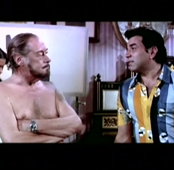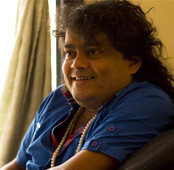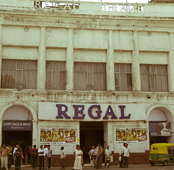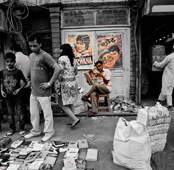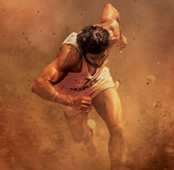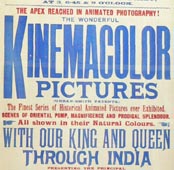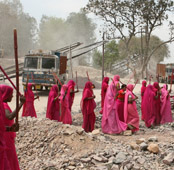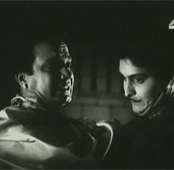The story of Regal Theatre, where the history of cinema meets the history of the country.
The really odd thing about Regal Theatre is the numbers on the back of its seats. Walk by behind a tattered row in the front stalls and you will most likely find them out of sequence. ‘6’ comes after ‘9’. Then ‘11’, and so on. Like torn pages from a history book, shuffled, till you suddenly have Jawaharlal Nehru staring you in the eye.
In the early 1940s Nehru had come in to Delhi from Rangoon, with a film called Delhi Chalo on the war of liberation Subhas Chandra Bose was fighting against the British in the East. His relative, Rajan Nehru, requested Rajeshwar Dayal to show the film at Regal. “I did not realize the risk involved in screening this uncensored film,” Dayal wrote on the theatre’s Golden Jubilee, in an article in a film journal called Screen, in 1988. It had been barely a few years since he had taken over the lease for the cinema in 1939. “I was surprised when I found that the full Congress High Command including Pandit Nehru came to this film,” he writes. The authorities found out. Dayal was sent a showcause notice asking why his license shouldn’t be cancelled. He rushed to Nehru for help. Finally, City Magistrate Kanwar Mahinder Singh Bedi bailed them out. That Nehru, seen as being at odds with Bose during this period, would go to such lengths to screen a film showcasing his work may seem strange. But nuances tend to emerge when you shuffle history.
There were palm trees at Regal’s porch back then. The foyer had chandeliers. The staff would don dinner suits and, on occasion, bow ties. Scotch and soda was available for seven and a half annas. Tickets for anything between eight annas to three rupees. Everyone would stand in queue, including the Deputy Commissioner of Delhi, the highest local authority at the time. “A thick maroon velvet curtain adorned the stage,” writes Dayal. When the Viceroy or Governor General visited, a red carpet would be laid out.
Located today in the middle of the crazy bustle that is Connaught Place, Regal, say reports, was the first building in the area. It was built in 1932, by Sobha Singh and designed by British architect Walter Sykes George (Dayal also credits Herbert Baker, who was working, along with Edwin Lutyens, on what would come to be known as Lutyen’s Delhi, for inputs.) Called the New Delhi Premier Theatre in the beginning, Regal, as it was renamed shortly after, came up with a large central porch, a sloping roof and brick masonry throughout. It went on to host, along with Hollywood movies, Western Classical maestros, Russian ballet and British theatre groups. On the top floor was a restaurant called Davicos (later ‘Standard Restaurant’) that was the toast of the town. “Is there truth in the rumours that New Delhi has become more cosmopolitan?” Hindustan Times columnist Captain P. L. Rau had asked after visiting Connaught Place in 1936. This cinema, the cultural epicenter of not just Connaught Place but also the new capital, formed a part of the answer.
“Kisi se nahin mila. Main chay baje chalaa jaataa hoon. (I met no one. I leave at six o’ clock in the evening).”
Amar Singh Verma has been working as an accountant at Regal since 1977. The lease of the cinema was transferred from the Dayal family to Vikas Mahajan—a hotelier from Jammu who spends his time in between the city and Delhi—in 2006. Verma, 73, is the only one around in the theatre who has witnessed Regal’s past years of glory, a meticulous citation that keeps reappearing on pages from its history, recounted in innumerable articles. He is wiry but dignified in the way that gentlemen from another era are, with grey hair combed neatly back, a shadow of a moustache and rimmed glasses. He is wearing a cream coloured shirt and dark brown trousers. He retired 12 years ago but still oversees things at the theatre, continuing in a kind of informal employment, because he feels he “is not employed but belongs here”. He lists dignitaries who’ve visited the theatre. “Lord Mountbatten, Pandit Nehru, Dr. Rajendra Prasad, Dr. Zakir Hussain, Indira Gandhi… kisi se nahin mila,” he says, matter-of-factly, without a trace of regret. “Main chay baje chalaa jaataa hoon.” The dignitaries, apparently, always watched night shows.
The corridors and staircase of the cinema hall are lined with large black and white photographic portraits of stars from the yesteryears. Dev Anand, Meena Kumari, Nargis, Raj Kapoor… “Raj Kapoor and Nargis would spend time in this room,” says Verma. We are at his office, a tiny wood and glass cabin at the entrance to the cinema. “If someone intruded on their privacy they would scold them and shoo them away.” He giggles faintly. A stoic man, this is the first time his eyes light up. He remembers there being a line all the way to Malik Sweets, a few blocks away, for Raj Kapoor’s films. Verma saw Kapoor during the premiere of Satyam Shivam Sundaram (1968). He had not been working here then. “The whole theatre was decorated with flowers,” he remembers. “There was a havan (a Hindu ritual in which fire is worshipped) before the film began.” Among the first films Verma remembers watching here are Dilip Kumar’s Leader (1964) and the social drama Khilona (1970). The latter, a tale of how a tabloid editor gets ensnared by a politician-criminal nexus he then exposes, was a movie Kumar agreed to do after doctors advised the actor against taking on any more tragic roles as they were sapping him emotionally. “It shows you how political leaders exploit people and how they get their comeuppance, as they should,” says Verma with some feeling. He is disillusioned with the films of today. He cites the absence of social messages and a change in the conventional aesthetic of filmmaking as two reasons for the disconnect he feels from contemporary cinema. “Dance ke naam pe yog hota hai (in the name of dancing, you have people doing yoga on screen),” he says.
Dayal, one of the early champions of Hollywood in India, was not quite as conservative. In 1938, he travelled to Calcutta to book British films. He met Metro Goldwyn Mayer’s representative in India, Arthur Rolland Jones, who later became his “guru”. “For the first six, seven years, I used to type, myself, advertisements in newspapers,” Dayal writes. One of these was for Greta Garbo’s Ninotchka (1939) which had its North India premiere in Regal in December, 1940. Like with Leader and Kumar, the film was a departure from Garbo’s sombre and melancholy image. “Garbo Laughs!” the advertisement for it read. “Garbo Blushes!” “Garbo Loves!” Dayal would hang out with stars like Kenneth More and Lauren Bacall when they visited Delhi. Regal eventually also became a coveted venue for international film festivals. Eventually, besides English movies, Dayal began screening Russian films too. He remembers Mrs. Indira Gandhi had come to the theatre with her grandchildren for Operation Tiger.
There are other reminiscences in his account of those days. Dayal and his family would travel to Russia, often, as invitees at the Tashkent and Moscow Film Festivals. The Indian ambassador to the Soviet Union then, I. K. Gujral, who later became Prime Minister, was a friend of his. Dayal and his wife Niranjan Rani visited London to attend the world premiere of A Queen Is Crowned, shortly after Queen Elizabeth’s coronation in 1953. They were guests of Lord J. Arthur Rank, Chairman of Rank Pictures and Pinewood Studios. The screening was “graced by the Royal Family”, Dayal writes.
“Woh shauq se, izzat se picture dikhaatay thay (He would show people movies with passion and with grace),” says Verma of Dayal. “Woh samay aisa thaa— picture dikhaatay toh kaam ho jaata tha (Those were the days when, if you showed someone a movie, they would do your work for you).” Verma doesn’t make any bones about saying that it was primarily because of running Regal that Dayal had many friends in high places, in India and abroad. He passed away in 2005, at the grand age of 93.
His son Sidheshwar Dayal, who passed away four years ago at the age of 71, has an article in the same issue of Screen on Regal and off-beat cinema. Born in the year his father took charge of the theatre, Sidheshwar’s life runs parallel to the Dayal family’s association with Regal. “I was considered lucky for my parents because my father, in that very year, signed a contract with MGM,” he writes.
Sidheshwar’s writes that his earliest memories of cinema are the films Chandralekha (1948), Andaz (1949) and Barsaat (1949) as well as a party the Dayals threw for Raj Kapoor at their house after the premiere of Barsaat. He believed the films of the fifties and sixties were “a beautiful blend of art and commerce”. Later, however, Indian films degenerated rapidly into “make-believe entertainment, stereotyped stories… ” “Situations were increasingly being shoehorned into every film,” he writes. It was at such a time that Regal screened Mrinal Sen’s Bhuvan Shome (1969) on December 4, 1970. It received “wide appreciation” and did “reasonably well at the box office too”. Films that followed at Regal include Basu Chatterji’s Sara Akash (1969), M. S. Sathyu’s Garm Hava (1974), Shyam Benegal’s Ankur (1974) and Nishant (1975), Govind Nihalani’s Aakrosh (1980), Shekhar Kapoor’s Masoom (1983) and Mahesh Bhatt’s Saaransh (1984). The Film Finance Corporation, NFDC’s predecessor, sought out Regal to stage a festival of its films.
“There are either good films or bad films,” writes Sidheshwar, while talking of the distinction between commercial and art cinema. “In principle, there is no such distinction,” he says.
Speaking about the cinema of the seventies and the eighties, Sidheshwar says, “The dream of every filmmaker was not to make a good film but a box office hit by hook or crook.”
A sweeping statement perhaps, but the other pages of Screen, where this article appeared in 1988, seem to stand testimony to his words. They too present a history of sorts. One has an advertisement for Khatron Ke Khiladi, where Dharmendra, the face of so much remarkable cinema in the sixties, plays a vigilante dressed like Zorro with a machine gun. On another page is a poster of Tohfa Mohabbat Ka with Kimi Katkar wearing a swimsuit, her hand on the shoulder of a young Govinda, who is wearing a pair of gaudy sunglasses and a muffler and holding a revolver. Elsewhere in the poster Katkar appears in something that looks like a tribal crown, designed, possibly, by Bombay’s Maganlal Dresswalla in the eighties.
Shuffle again. There are stories about Asha Parekh directing a Gujarati TV series for women and Mithun Chakraborty being “hand-in-glove” with the Left government in West Bengal (he’s with the Trinamool Congress now, the Left has been routed in the state) and organizing a gala event for them. On another page, next to a photograph of Meenakshi Sheshadri marching to Vaishnodevi, Chakraborty appears again. Apparently he and the actress Neelam got into a bit of a tiff on the sets of a film they were shooting, because she couldn’t understand the English he spoke. “I beg your pardon,” she would keep saying. So he decided to mimic her. On hearing this Neelam “said ‘hell’ and walked out into the lawn”.
The report goes on to say:
“The photographers who had accompanied us followed her and she continued to pose for all of them, if only to be away from Mithun.”
Another actress, Sonam, was also on set: “She replied in monosyllables looking far into the sea. As if immersed in some deep thought which needed greater attention.”
The issue of language creeps up again, on the same page, in a report on Tamil producer K. L. Baase producing a Hindi film whereas he “is not at all conversant in the language.”
The reports form part of a column called ‘Sound, Camera, Clap’ by Jivraj Burman. He makes everyone in the film business sound insane.
As I look over these pages the audience begins to line up outside Regal. The first show of the day is about to begin. Heropanti is showing presently. The popcorn and soft drink counters are being readied. “We will have a good house,” says Verma. “We have a good house still, sometimes. But not the same crowd.”
Sidheshwar’s wife Chandni Dayal, 70, is the only surviving member of the family to have actually seen Regal’s heydays. She and Sidheshwar were without child. They adopted a son but, according to Verma, “He had no interest in the theatre business and is now managing Sidheshwarji’s other businesses instead.” Chandni is reticent when asked about why the family sold the theatre. “Sidheshwarji’s health was not keeping up. He had constant bouts of asthma,” is all she offers by way of an answer. One of her earliest memories of the theatre is watching Raj Kapoor’s Bobby (1973). “The havan, Raj Kapoor coming over to their house to talk to Sidheshwar” are things she remembers besides the film itself.
But more precious to Chandni than her own memories are the stories. Stories of how Regal would run practically empty during the summer months in the forties, when the British would retreat to Shimla. The showing of the 1939 epic Gone With The Wind. How soldiers would flock to the theatre during the war to see films like Pride and Prejudice (1940), The Great Dictator (1940) and Madame Curie (1943). How the cinema would be requisitioned by the Army in the mornings for secret and confidential lectures. “What can I tell you,” says Chandni. “You should go and speak to those who were there then.” As if Rajeshwar Dayal, Jawaharlal Nehru and Raj Kapoor were still sitting around Regal’s dusty misnumbered seats, waiting for a movie to begin. “All I have is stories I’ve heard from my father in law,” she says. “I married into a family with many stories.”
House of Light and Shadows
Article - Video and written featureJune 2014
 By Rishi Majumder
By Rishi Majumder
Rishi Majumder is Senior Editor at The Big Indian Picture.


